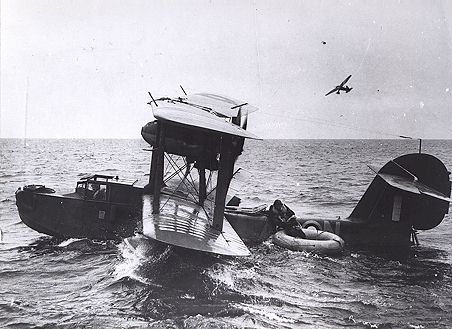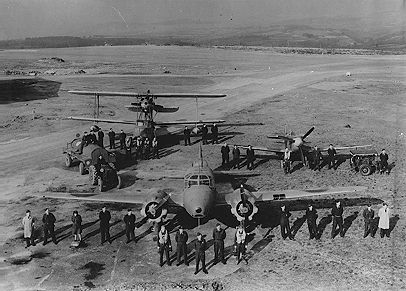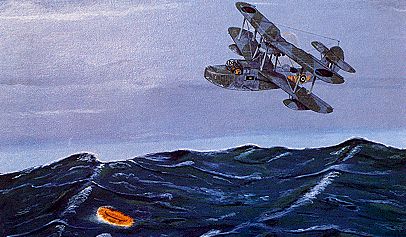
Supermarine Walrus
DOWN IN THE DRINK
By Merle Olmsted Historian, 357th Fighter Group
“They knew when they landed, that they couldn’t take off again.” These are the words of World War II fighter pilot Ollie E. Harris, in a 1995 telecon with this writer. He was paying tribute to the crew of a RAF Air Sea Rescue (ASR) amphibian, which had pulled him from the cold waters of the English Channel, some 50 years previous.
Harris was one of several thousand Allied airmen (and an unknown number of German) whose lives were saved by the ever vigilant ASR service of WWII. There are no precise figures available on exactly how many were rescued in the years 1940-45 and sources vary widely.
In March 1945, in a secret report from the Headquarters, 65th Fighter Wing, to Lt. General James Doolittle, Cmdr, Eighth Air Force, outlined the history of ASR in the 8th Air Force. This highly useful document titled “Shepherd of the Seas,” gives a figure of 938 men rescued from July, 1945. Unfortunately, it is not clear if this refers only to 8th AF crews, or if it is the total rescues during that period.
In any case, British ASR historian Sid Harvey believes the number is far to low. His research leads him to believe that about 2,000 U.S. airmen were rescued and about 4,000 British (over a much longer period). This is about 40% of those airmen who went down in the waters around Britain. U.S. percentages taken by themselves, are somewhat higher at about 66%, for two reasons. First, because their operations were in daylight hours, as opposed to much RAF night activity. Second, by the time U.S. operations were reaching a crescendo in 1943/44, the ASR service was vastly more efficient than it had been two years before.
It should be kept in mind however, that if 40% (or 66% U.S.) were saved from the sea, that 60% (or 34% U.S.) were not rescued and they have no grave except the Channel or the North Sea. A significant portion of the 5,000 names on the Wall of the Missing at the American Cemetery at Cambridge, are of these men.
The purpose of this article is to relate the story of Ollie Harris, and other pilots of the Eighth Air Force’s 357th Fighter Group who were grateful “customers” of the aircraft and boats of the ARS (this was the most common name given to the rescued by the ASR crews). Before going into the tale of “The Yoxford Boys,” as the German radio dubbed the 357th, it is desirable to provide some background on the remarkable, and seldom told story of the ASR operations out of the British Isles in those long ago years of 1940-1945.

ASR – ITS ORIGINS AND HOW IT WORKED.
The war that burst upon Britain in 1939 was not unexpected, but in one way it was it was a particular shock. It had not developed as British military planners had prepared for. A major duty of any military force is to provide plans to deal with any possible contingency. All too often, some are not envisioned, and in this case, British strategists had not considered the possibility of German aircraft based only a few miles away in France and the Low Countries. They had expected to have these countries as buffer, as in W.W.I. However, the German’s lightening offensive that conquered France left them with the certainty of having to fight much larger concentrations of German aircraft, based within easy range of Britain.
With the availability of hindsight, this may be the reason why the British Air Ministry had given little or no thought to the ways and means of retrieving their aircrews after ditching at sea.
There were a few RAF and Royal Navy boats stations along the coasts in 1939, but no organized service. In a situation which brought a huge increase in over-water flying and over- water combat, it was a critical deficiency.
Although RAF bombers were equipped with dinghies, fighter pilots were not, having only a Mae West life jacket. It was not until after the Battle of Britain, in the spring of 1941, that they began to be equipped with dinghy packs attached to their parachute harness.
Neither dinghy or life jacket was of much use unless there was someone to extract them from the water. Both did nothing but prolong the end result, the Mae West for only a matter of minutes in the winter.
Some 6 months before the September outbreak of WWII, at a joint services meeting the first tentative steps were taken when responsibility for sea rescue was given to Coastal Command. Although this was beginning, progress was slow, fragmented, and very uncertain. It was not until after the Battle of Britain, and well into 1941, before ASR flights equipped with Westland Lysanders (and later some Avro Ansons) began to be formed along the coasts to act as search aircraft for the boats, the only actual rescue vehicles. Later on, aircraft such as the 4-gun turret equipped Boulton Paul Defient (which was not of much use for anything else) joined the Lysanders. Both were now equipped to carry dinghy packs, and were able to provide some service to those in the water.
As the service developed, Spitfires were also assigned directly to the ASR flights, to fly armed search and spotting.
In the fall of 1941, the Supermarine Walrus amphibian lumbered onto the ASR scene, about the time the RAF began to form it’s scattered flights into squadrons. The desirability of an aircraft that could “land” in the sea and affect rescues on its own had long been obvious.
First flown in 1933, the Walrus was, from an aesthetic point of view – a disaster! Two fabric-covered wings spanning 45 feet, perched on top of a wooden hull (early ones had metal hull), with a 9-cylinder 775 horsepower Bristol Pegasus radial inserted between the wings in a pusher mode, and driving an ancient 4-blade wooden propeller. Oddly, enough, this relic from the past was designed by R. J Mitchell, who also gave the aviation world two of its most beautiful machines, the Schneider racing seaplanes of the 1920s, and the graceful Spitfire. However, beauty is as beauty does, and the Walrus did its job in a magnificent manner. To men bobbing around in the sea, it was more a thing of beauty than the other two.
With the talent of the British services to bestow amusing apt and sometimes baffling nicknames and slang, it is no surprise to find that the Walrus was widely known as the SHAGBAT, with STEAM CHICKEN another favorite.
Even at the time, the Walrus could hardly have been considered ideal for sea rescue, due to its small size, single engine, and an inability to take off from the sea with more than five or six men aboard. (its normal crew was three.)
It had, of course, not been designed or purchased for rescue duty – it was basically a naval catapult launched aircraft for reconnaissance and to provide ranging information for the fleets big guns.
In 1941-45 however, it had at least two shining advantages, it was available and it was amazingly sturdy. There are many cases on record of the aircraft being taxied in mine-infested, storm-tossed seas, for hours, covering as much as 75 miles back to its base. Quite often it was in a damaged condition and overloaded with customers its crew had extracted from the water. Despite its lack of beauty and its disadvantages, uncounted numbers of aircrew survived because the SHAGBAT crews landed “when they knew they couldn’t take off again.”
By the time the 8th Air Force began to arrive in strength, there were six rescue squadrons, based in wide arc around the south and east coasts of Britain which faced the continent. Those waters would produce thousands of customers for the squadrons, which consisted of 275 through 278, which operated a mixture of land-based types and Walrus (later also Sea Otter) amphibians. The other two, 279 and 280, were equipped with long range Hudsons and Ansons and these were augmented by Royal Navy Walrus units in the same area.
The impression should not be taken however, that the SHAGBAT was the star of ASR. Covering these same south and east coasts were approximately twenty RAF and RN marine detachments equipped with several types of boats, of which the most important were the RAF’s HSL (High Speed Launch) and the larger Royal Navy RML (Rescue Motor Launch).
The marine units worked in close coordination with the aircraft, whose main job was to locate the men in the water, and orbit, dropping smoke markers, flares and dinghy packs, if required. The fixing stations could get a good fix on the orbiting aircraft and direct the boats to the scene. There are countless cases, however, where the marine units were not close enough, or the men in the water were in immediate peril, and it was then that the Walrus crews took a direct hand in the matter, often putting down in appalling sea conditions which made takeoff impossible. The only alternative was then to begin taxiing toward the English coast or a rendezvous with a launch, at which time the customers would be transferred to the boat and the aircraft taken in tow.
The whole operation required close and rapid coordination between the USAAF, the RAF, the RN and the vital communications and direction finding (or fixing) stations and ASR central control at Saffron Walden. In the rescue business, time is Precious – a few minutes can make the difference between life and death for those in the water.
With the increasing buildup of the 8th Air Force, which had no rescue service at all, it was inevitable that they would become involved with the British operation. By the spring of 1943, a high-level decision had been reached to transfer operational control to the AAF, but with responsibility for the actual rescue service would remain with the British units already in full operation. On the 4th of July, 1943, 65th Fighter Wing assumed full control, although RAF and RN presence remained until war’s end.
A year later, Detachment B, Flight Section, 65th FW was formed at Boxted to provide additional spotter aircraft. Twenty five war-weary P-47s were provided, modified to carry dinghy packs, smoke bombs, flare dispensers etc. Even with a dedicated spotter unit (which became 5th Emergency Rescue Squadron in March 1945), hundreds of Allied aircraft of all types were often involved in searches and as cover for rescues in progress.
As the war wound down in the spring of 1945, the 5th ERS could now begin to Join in the actual rescue when the excellent OA-10 Catalina was provided. About the same time, B-17s equipped to drop lifeboats entered service, Joining the similar equipped RAF Warwicks.
Although the 8th Air Force eventually had three fighter wings, the 65th was the first formed and it was assigned the additional duty of ASR. The wing’s fighter control center was located near Debden airfield in a former grammar school at Saffron Walden. In a glassed in corner of the control room the ASR operation under 52nd Fighter Control Sqdn, was in business on the 4th of July holiday 1943.
The duty day at Saffron Walden started much the same as at the bomber and fighter groups, with the arrival of the 8th AF Field Order, by teletype, in the early hours. The duty controller then plotted the “IN” and “OUT” courses to be flown by the bombers and fighters, and based on this, he chose the rendezvous points in the Channel and the North Sea, where he would place his boats. The same would be done for Detachment B’s P-47s, and all units were then notified of courses and RV points, and times to be on station. The boats required 3 hours minimum notice, with 1 hour for the P-47s and the other spotter aircraft. The P-47s always operated in pairs, one to stay low and orbit the customer in the water, the other to stay high and handle communications and to provide a “target” for the fixing stations, and to provide armed cover. When their fuel state required it, they would be relieved by another pair.
The duty controller also brought all of his fixer stations, ground and air based radio relay units into operation, and the ASR service was ready for the day’s work.
From the beginning of 1944, all Allied aircrew’s direct link with ASR assistance was through channel “B” on their VHF radio. Using the universal distress code MAY-DAY, they were in immediate contact with the ASR controller, who would often ask for a long transmission if the pilot’s circumstances allowed it. This improved the chances of the fixer stations getting a bearing. A pilot wounded or with damaged equipment could often only provide a brief and fragmentary transmission, which made it very difficult to obtain a fix.
This data was passed on to the appropriate rescue squadron and the closest launches. (The boats routinely monitored “B” channel themselves.) With the passage of time and experience the system worked well for the aircrew with the proper training to do their part, and a healthy dose of good luck.
The contributions of anonymous ASR controllers and the operators of the fixer stations brought hundreds of airmen home from the deep.


